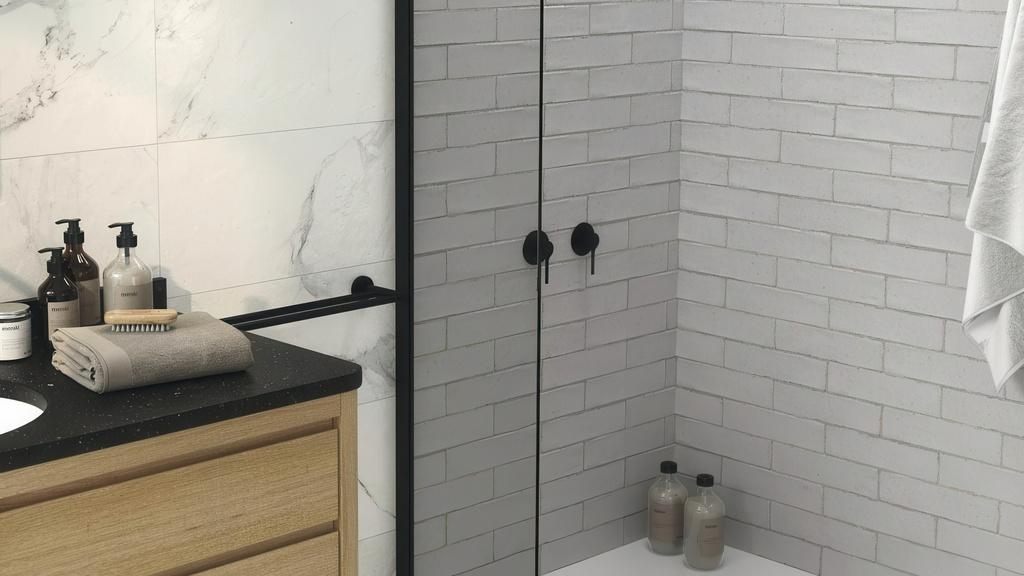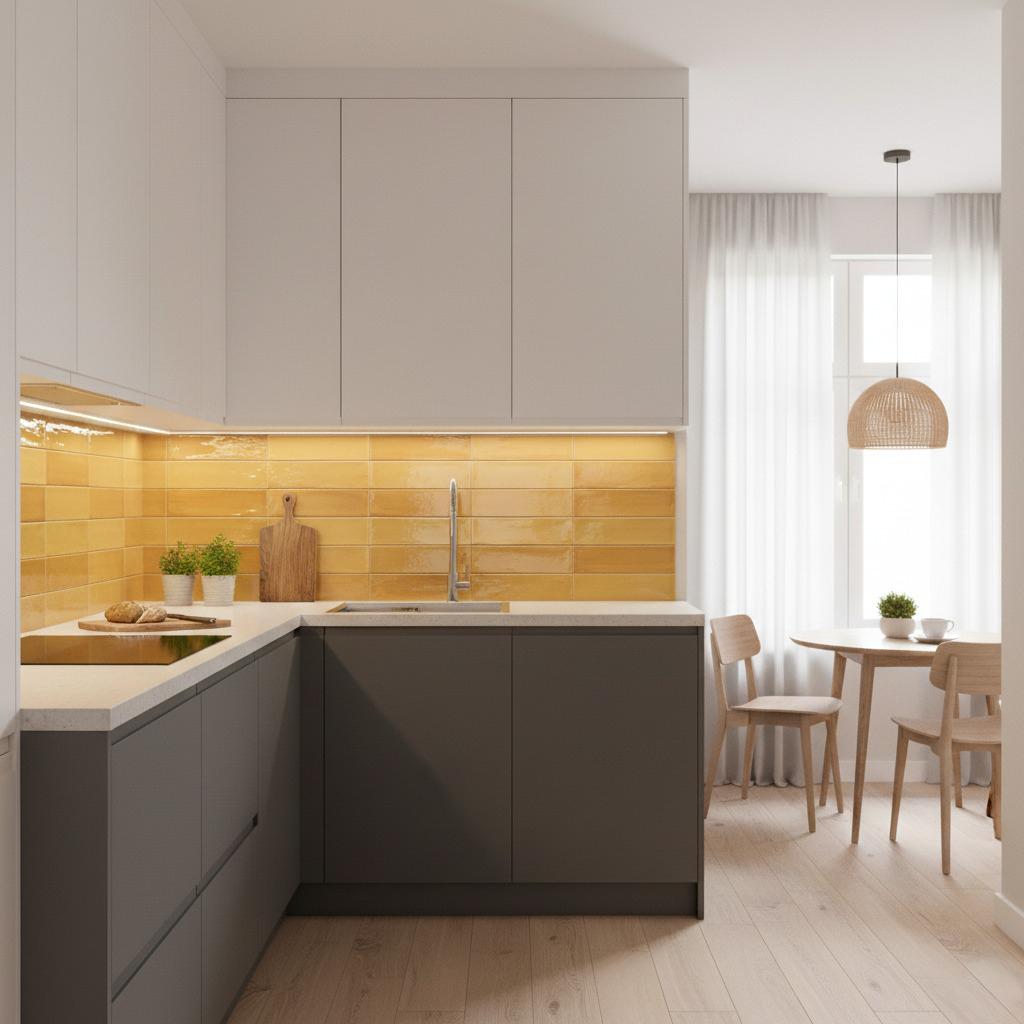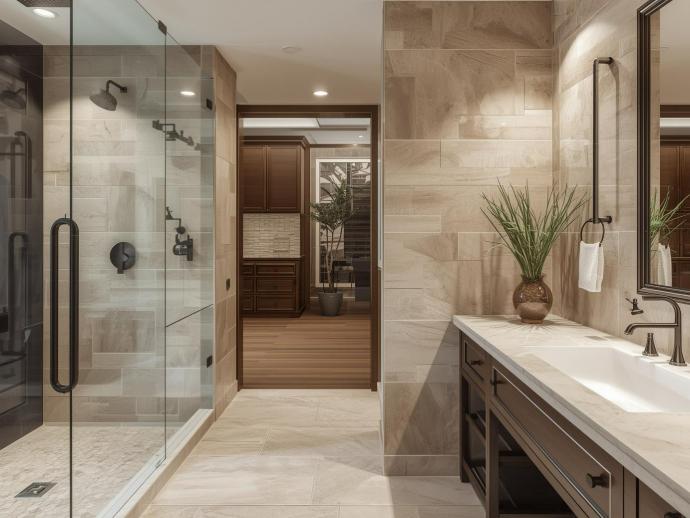Subway tiles for kitchens and bathrooms in 2025 come in multiple sizes (3x6-inch, 4x12-inch, 2x8-inch), materials (ceramic, porcelain), and finishes (glossy, matte, textured).
The best subway tiles depend on your specific application: glossy ceramic works best for kitchen backsplashes due to grease resistance, while porcelain with water absorption rates below 0.5% excels in bathroom showers and high-moisture areas.
Popular colors include classic white, sophisticated gray, navy blue, and warm terracotta tones. Installation costs vary based on material quality and professional labor, with projects typically lasting 20-30 years.
Key factors when choosing subway tiles include finish type (glossy reflects light and resists stains; matte hides water spots), size selection (larger formats like 4x12-inch reduce grout lines and maintenance), and proper water absorption ratings for wet areas.

Understanding Modern Subway Tile Choices
The traditional subway tile measures 3 inches by 6 inches, but today's market offers expanded dimensions to suit various design preferences. From compact 2x4-inch formats to elongated 4x12-inch options, the range provides flexibility for any project scale or aesthetic vision.
Ceramic options deliver reliable performance with excellent moisture resistance and easy maintenance. The glazed surface creates a protective barrier against water and stains while offering vibrant color options. These tiles work beautifully in both kitchens and bathrooms, providing durability that lasts for decades.
Porcelain alternatives represent superior density and water absorption resistance. With absorption rates below 0.5%, porcelain excels in high-moisture environments like shower surrounds and areas behind soaking tubs. According to industry experts, the material withstands temperature fluctuations better than ceramic, making it ideal for demanding applications.
Glossy finishes reflect light beautifully, making spaces feel brighter and more expansive. The smooth, non-porous surface resists grease and cooking splatters, proving especially practical for kitchen backsplashes. These finishes also amplify color depth, creating vibrant surfaces that catch the eye.
Matte finishes have surged in popularity for their contemporary, understated elegance. They hide water spots and fingerprints more effectively than glossy alternatives, reducing visible maintenance between cleanings. The non-reflective surface creates calming atmospheres perfect for spa-inspired bathrooms.

Top Kitchen Applications
Kitchen environments demand tiles that handle grease, heat, moisture, and frequent cleaning while maintaining aesthetic appeal.
White ceramic subway tile with glossy finish remains the cornerstone of kitchen backsplash design. This timeless choice brightens kitchens, makes spaces feel larger, and complements virtually any cabinet color or countertop material. The reflective surface cleans effortlessly, maintaining its pristine appearance even in busy cooking areas. Our glossy ceramic collection provides reliability that preserves their finish for decades.
Gray subway tiles offer versatile neutrality that bridges warm and cool design schemes. From soft dove gray to deep charcoal, these tones complement stainless steel appliances, natural wood cabinetry, and colorful accents without overwhelming spaces. They create modern sophistication while remaining practical for everyday use.
Navy blue subway tiles make dramatic statements in contemporary kitchens. Deep blue tones contrast beautifully with white cabinetry while adding sophisticated color that feels intentional rather than trendy. Design trends for 2025 show these work particularly well as backsplash features behind ranges or as full-wall installations in open-concept spaces.
Terracotta and rust-toned subway tiles bring Mediterranean warmth to kitchens. These earthy shades create cozy, inviting environments that pair exceptionally well with natural materials and warm metal finishes.
Oversized tiles measuring 4x12 inches create contemporary aesthetics with reduced grout lines. Fewer grout joints mean simpler cleaning and more streamlined appearances. The elongated format emphasizes horizontal lines, making kitchens appear wider and more expansive.
Premier Bathroom Solutions
Bathroom spaces require tiles that excel in persistent humidity while creating tranquil, refined atmospheres.
Beveled subway tiles feature angled edges that capture light and generate subtle shadows throughout the day. This dimensional detail elevates standard flat tiles without appearing ornate. Available in multiple finishes, beveled options work beautifully around vanities and in shower enclosures, adding refined sophistication to any bathroom.
Three-dimensional designs introduce raised patterns and geometric reliefs that transform walls into architectural features. These dimensional surfaces create striking focal points as natural and artificial light shifts across raised textures. Wave patterns add organic movement, while geometric shapes deliver contemporary edge. Use these strategically on accent walls or shower features where textural interest enhances the overall design.
The classic 3x6-inch format remains the most popular bathroom choice. These proportions work seamlessly in showers, around tubs, and as complete wall covering. The familiar size offers flexibility to navigate fixtures, outlets, and corners without excessive cutting. Multiple installation patterns from traditional running bond to vertical stacking or herringbone create varied visual effects using identical tiles, as explained in professional installation guides.
Sleek 2x8-inch and 4x8-inch formats emphasize horizontal lines while reducing grout line maintenance. These elongated rectangles suit modern bathroom designs where streamlined appearances take priority. The contemporary proportions make compact bathrooms feel more spacious while delivering sophisticated visual impact.
Color Trends Shaping 2025
White subway tiles maintain their position as the most versatile choice. Pure white, off-white, and cream tones work across all design styles from traditional to contemporary. White reflects maximum light, making bathrooms and kitchens feel bright and spacious.
Gray subway tiles bridge warm and cool palettes with ease. Light gray creates subtle interest without overwhelming spaces, while charcoal makes bold statements in powder rooms and behind ranges. Gray tones complement virtually every fixture finish, from chrome to brushed gold.
Blue subway tiles bring coastal charm and calming energy to bathrooms. Pale sky tones create airy feelings in compact spaces with limited natural light. Medium cerulean shades add noticeable interest to kitchen backsplashes. Deep navy selections deliver luxurious sophistication, especially when paired with brass or gold fixtures.
Brown subway tiles in caramel, taupe, chocolate, and espresso hues create cozy, grounded environments. These warm tones complement natural wood elements and brass fixtures beautifully. Terracotta and rust shades continue gaining popularity as homeowners embrace warmer palettes.
Subtle pink and dusty rose subway tiles provide gentle color that works surprisingly well in both modern and traditional settings. These shades add personality without appearing overtly feminine, creating sophisticated spaces that feel intentional and refined.

Installation Patterns and Grout Choices
The traditional horizontal brick pattern, offset by half a tile width, creates timeless appeal. This familiar arrangement makes narrow rooms feel wider through horizontal visual movement. Running bond works beautifully with modern furniture while maintaining classic charm.
Arranging tiles in straight vertical columns draws eyes upward, making ceilings appear higher. This pattern suits small bathrooms and compact kitchens where creating a sense of openness matters, according to professional planning standards.
Diagonal V-shaped patterns transform simple rectangular tiles into sophisticated geometric art. Herringbone creates dynamic visual interest that commands attention. This pattern works especially well on accent walls or backsplash features.
Selecting grout that matches tile color creates seamless, flowing appearances where grout nearly disappears. This approach works beautifully with colored tiles, making spaces feel larger and more cohesive. Proper grouting techniques ensure professional results that last.
White grout with colored tiles creates crisp definition that emphasizes individual tiles. This classic combination works especially well with blue, gray, and brown tiles, delivering coastal or traditional aesthetics.
Charcoal or gray grout with light tiles creates bold grid patterns that add graphic impact. This contemporary approach works well in modern spaces. Dark grout also hides everyday wear more effectively in high-traffic areas.
Quality and Investment Considerations
Quality tiles maintain uniform dimensions across batches. Consistent sizing ensures straight grout lines and professional-looking installations. Tiles rated as impervious or vitreous work best in wet areas like showers and tub surrounds. These low-absorption ratings prevent water penetration, as outlined by industry installation standards.
Harder glazes resist scratching and wear, maintaining their appearance longer. Kitchen backsplashes in high-traffic cooking areas benefit from durable surfaces that withstand daily use without degradation.
Subway tile projects represent significant home improvement investments. While budget considerations matter, remember these installations typically last 20-30 years or more. According to market research data, choosing quality materials makes financial sense when considering long-term performance.
Expert installation ensures proper waterproofing, alignment, and finishing. Labor costs often equal or exceed material expenses, but professional workmanship delivers results that last decades, as emphasized by remodeling professionals.
Well-executed tile work adds measurable value to homes. Kitchens and bathrooms significantly influence property values, and quality installations signal overall maintenance and care, according to home renovation experts.
Conclusion
Choosing the right subway tiles involves balancing aesthetic preferences with practical requirements. Classic white ceramic tiles continue offering unmatched versatility and value, while specialty finishes and colors transform spaces into unique expressions of personal style.
The enduring popularity of these rectangular tiles stems from remarkable adaptability. They work in virtually any design context, from historic renovations to cutting-edge contemporary spaces. By understanding available materials, finishes, sizes, and colors in 2025, you can make informed decisions that serve your space beautifully for decades. Contemporary bathroom designs showcase how these timeless tiles continue to inspire modern interiors.
At Nova Tile and Stone, we encourage you to take advantage of our free consultation service to explore options. Our sample program allows you to view tiles in your actual space under different lighting conditions and consider how they complement your existing finishes. Visit our showrooms or explore our complete collection to discover the perfect solution for your project. This thoughtful approach ensures your investment delivers lasting satisfaction.
Frequently Asked Questions
What is the most popular subway tile size for bathrooms?
The standard 3x6-inch format remains the preferred bathroom size. This classic dimension works beautifully in showers, around tubs, and as wall covering in any sized bathroom. The proportions create visual interest without overwhelming smaller spaces, and the size offers sufficient flexibility to work around fixtures and outlets without requiring excessive cutting.
Are matte or glossy subway tiles better for kitchens?
Glossy tiles generally excel in kitchens because their smooth, non-porous surface resists grease and cooking splatters more effectively. They also reflect light, making kitchens appear brighter. However, matte porcelain options show water spots less noticeably. For backsplashes behind stoves, glossy finishes offer easier maintenance.
How should I budget for a subway tile project?
Budgeting requires considering both material and installation expenses. Quality matters significantly since these installations typically last 20-30 years or more. During your free consultation with our experienced team, we can discuss your specific project scope and desired materials while providing guidance on creating realistic budgets.
Can subway tiles work in modern contemporary homes?
Absolutely. Subway tiles adapt beautifully to contemporary design through careful selection of size, color, and installation pattern. Larger format options create cleaner lines with fewer grout joints, perfect for minimalist aesthetics. Browse different styles to find matte finishes in monochromatic colors that deliver modern sophistication.
Do colored subway tiles go out of style faster than white?
While white subway tiles offer unmatched timelessness, well-chosen colors demonstrate remarkable longevity. Neutral colors like soft gray, beige, sage green, and navy have proven staying power. The key involves selecting colors with broad appeal rather than trendy shades. Explore our mosaic collection and coordinating options to create designs where earth tones typically age better than bright, saturated colors.
